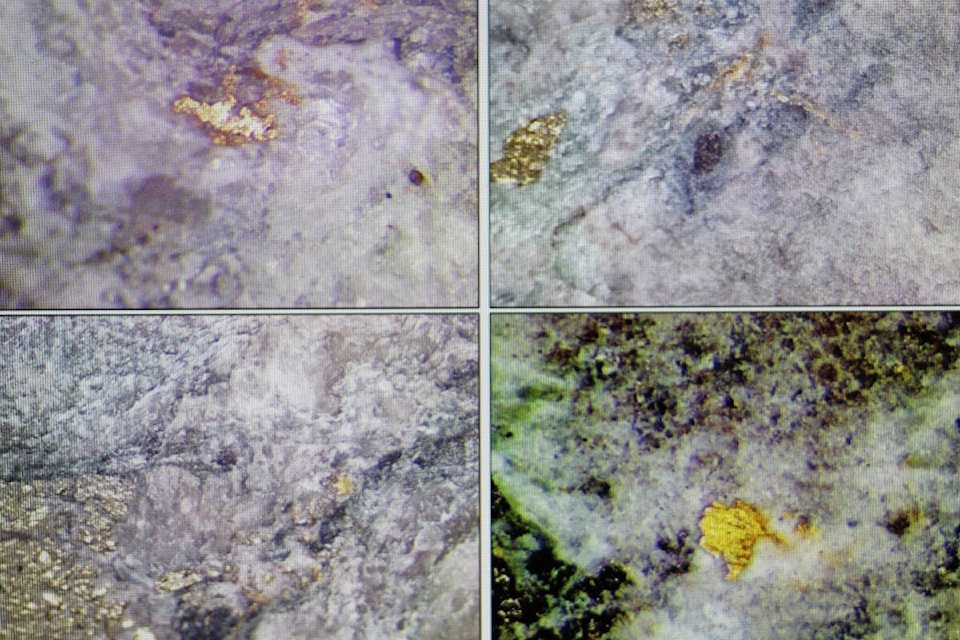According to West High Yield (WHY) Resources, there’s still a lot of gold in them hills.
WHY reported significant gold and silver finds at its Midnight Gold Claim near Rossland last month.
According to a Sept. 20 press release, WHY’s exploration hit major gold deposits on its recent drilling program, citing a certified assay report that discovered a deposit of 311 grams per tonne (g/t) of gold (Au).
“We were excited to identify visible gold in high-grade assay intervals in MN22-05,” said Greg Davison, P.Geo and Qualified Person (QP) for Midnight in a release. “And the assays using gravimetric and metallic screen protocols verified the significant gold grades from 14 g/t Au to 33.7 g/t Au, and 311 g/t Au, respectively, in four sample intervals contained within a 17.5 metre core intersection.
“Screen metallics confirmed elevated gold in the coarse fraction (1,460 g/t Au), which contributed 20 per cent of the contained gold and an average of 277 g/t Au for the fine fraction for the 0.3 metre interval for 69.95m to 70.25m.
In addition, anomalous silver (Ag) values for the latter interval were reported at 94.9 g/t.
CEO Frank Marasco was surprised at the current assay results, but believes they are literally just scratching the surface.
“We were expecting between one and three ounces, not 10 ounces,” Marasco told the Rossland News. “When you hear about gold today it’s usually two grams, three grams, five grams, eight grams and that’s it, because it’s all depleted around the world. There are the odd ones, but 80 to 90 per cent are in the grams. So we’re very blessed.”
WHY’s exploration program is focused on finding historic zones of known Midnight mineralization, areas with high yield potential, and deeper targets below. The current finds were within 70 metres of the surface, but WHY expects to discover even larger fields as deep as 600-m.
“We are on hole 33 and we only have assays (results) back from four-and-a-half holes,” said Marasco. “We expect to get a significant amount of news releases out there, but they are so far behind it’s unbelievable.”
WHY owns 8,900 hectares of undersurface mineral rights at Record Ridge, about eight kilometres north of the U.S.-Canada Border. They have done extensive mineral analyses that also indicate significant deposits of magnesium, nickle, silica, and iron-ore. WHY does not currently have surface rights, with the exception of access and disturbance agreements with the BC government for exploration.
Marasco says he knows this is a drawn out process, one he has been involved in for almost two decades.
“It’s a slow process. I’ve been there for 19 years in October, four years on gold and 15 on magnesium and it’s not an easy task.”
A few kilometers away from the gold drill sites, WHY also discovered a magnesium field on Record Ridge. WHY commissioned a pre-feasibility study and submitted an amended joint Mines Act-Environmental Management Act permit application to the B.C. Ministry of Mines on Feb. 14 and 15, respectively, for the development and operation of its Record Ridge Industrial Mineral Mine Project.
“It’s quite a distance away, and you have to go through the same protocol as we did Record Ridge,” said Marasco. “So this is probably eight to 10 years away on the gold side, so that’s a long, long ways away.”
The current area of drilling is focused on the targets from surface to 200 metres depth located to the southeast and east of the historical high-grade Baker Vein.
The second drill is exploring deeper targets from 200 metres to more than 600 metres transecting the andesite-ultramafic contact and below the Baker Vein between the Midnight and IXL claims. The third drill is targeting highgrade polymetallic mineralization reported and observed from the OK Mine area drilling.
Marasco says he doesn’t see a massive mining operation going in, but believes there is potentially direct benefits for Rossland, pointing to sustainable job creation, a reliable generator of cash flow and an opportunity to secure markets for all its elements.
Prior to 1900, Rossland had the largest gold mine in the world and was considered to be the gold capital of B.C. From the 1890s to the 1930s Rossland extracted 84 tonnes of gold, earning its reputation as the “Golden City.”
Gold mineralization in the Rossland area is reported to depths in excess of 750 metres. The Rossland Gold Camp historically produced over 2.76 million ounces of recovered gold and 3.52 million ounces of recovered silver.
Read: Mayor concerned about open pit mine proposal near Rossland
